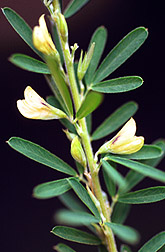This page has been archived and is being provided for reference purposes only. The page is no longer being updated, and therefore, links on the page may be invalid.
|
|
Forage Plant Wards off Ruminant Gastrointestinal Nematode
By Sharon DurhamFebruary 18, 2010
A common pasture plant could help foraging ruminants ward off damaging gastrointestinal nematodes that can cause illness and death, Agricultural Research Service (ARS) scientists report.
Animal scientist Joan Burke at the ARS Dale Bumpers Small Farms Research Center in Booneville, Ark., along with colleagues at several universities, has patented formulations of Sericea lespedeza, commonly referred to as Chinese bush clover. The plant was introduced in the United States in the 1930s to minimize soil erosion.
Adding the patented dry hay and pelleted forms of this plant to animal feed thwarts the reproductive cycles of gastrointestinal nematodes that are in the digestive tracts of goats and sheep. It is particularly effective in controlling the barber pole worm (Haemonchus contortus), a nematode that attaches to the animals’ abomasal (true stomach) wall and feeds on their blood. Female worms can produce more than 5,000 eggs per day that are shed in the animal’s manure.
After hatching outside the animal, H. contortus larvae molt several times, resulting in a more developed and infectious larval form on grass leaves that animals consume during grazing. Once the infectious larvae are inside the animal, they suck the animal’s blood, potentially leading to anemia, weakness and even death.
In the southern United States, goat production for meat or milk is an attractive alternative business for farmers because of the comparatively low cost of breeding stock, the high reproductive rate of goats, and the animals’ ability to thrive on native pastures or brushland that is unsuitable for cropping. The major hindrance to economic goat production in this region is infection with gastrointestinal nematodes, particularly H. contortus. This parasite causes large economic losses for farmers around the world, and the worm has developed resistance to chemical interventions.
Burke, Jorge Mosjidis at Auburn University in Alabama, Thomas Terrill at Fort Valley State University in Georgia, and James Miller at Louisiana State University are co-inventors on the patent awarded in November 2009.
ARS is the principal intramural scientific research agency of the U.S. Department of Agriculture (USDA). This research supports the USDA mission of promoting international food security.

